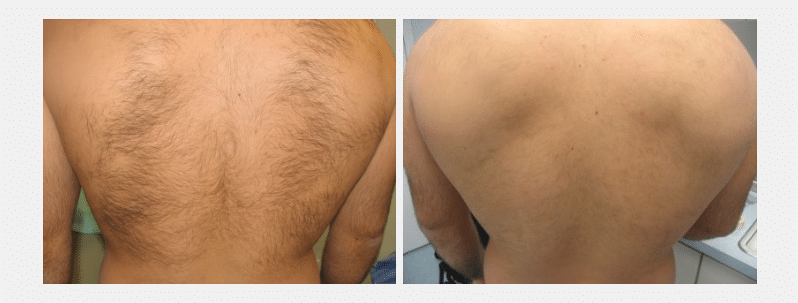Laser Hair Removal
Laser hair removal is a cosmetic procedure used to remove unwanted body hair with pulsed laser energy. This procedure removes hair from the targeted area while leaving the surrounding skin unharmed. Common areas on which laser hair removal is performed are the chin, upper lip, chest, underarms, back, bikini line and legs. Areas targeted are usually somewhat dependent on the gender of the patient.
While there are many temporary treatments to remove unwanted hair, such as tweezing, shaving, using depilatory creams and waxing, patients seeking more permanent, less irritating or painful methods, are frequently very pleased with laser hair removal. Through this safe, painless procedure, patients can enjoy long-term hair removal from nearly any area of the body with the exception of the eyes since there is a possibility of serious eye damage.
Who are Good Candidates for Laser Hair Removal?
Individuals whose excessive hair growth in a particular region of the body is bothersome are candidates for laser hair removal. Excessive hair growth may be the result of heredity, certain medications or disease processes, or hormonal changes during puberty, menopause or pregnancy, Whatever the cause of the condition, laser therapy may be an effective solution.
The success of laser hair removal is affected by hair color and skin type. The most effective results usually occur in individuals with dark hair and light skin. This is because the laser beams target the melanin, or pigment, in the hair. Individuals with blond, red, gray or white hair are not usually good candidates for laser hair removal. Recent technological advances have made laser hair removal for dark-skinned individuals more successful, while procedures to effectively remove light-colored hair with lasers are presently under investigation.
What are the Benefits of Laser Hair Removal?
There are many benefits to having unwanted hair removed through the use of laser therapy. Among these are that laser hair therapy is:
- Precise, targeting dark coarse hairs for immediate removal.
- Quick, removing upper lip hair in only minutes
- Long-lasting, showing permanent results for 90 percent of patients
Laser Hair Removal Procedure
Laser hair removal is performed while the targeted area is numbed by a topical anesthetic. A handheld device that emits intense laser pulses is moved across the region, focusing on individual hair follicles. There are several different methods of laser hair removal, some of which combine laser impulses with radiofrequency. An appropriate method for each individual patient is decided in consultation with the physician administering treatment.
Hair growth takes place cyclically in three stages. The most effective laser hair removal takes place during the andogen, or full-growth stage. Hair follicles that are in a stage of active growth will be disabled by the laser energy, stopping continued hair growth. Because all of the hair is not in the same stage of growth at any given time, several laser treatments, usually between three and five, spaced 4 to 8 weeks apart, are necessary. To some extent, the length of necessary treatment will depend on the location and texture of the patient’s hair.
For many patients, laser hair removal is painless. Some individuals experience minimal discomfort, usually described as something like a rubber band snapping against the skin.
Before and After Pictures of Laser Hair Removal
Click here to view more Laser Hair Removal Cases
Recovery from Laser Hair Removal
Some redness, soreness or swelling may occur immediately after a laser hair removal treatment, but these symptoms almost always disappear within a few days. Cold compresses or ice packs, moisturizers, and anti-inflammatory creams may minimize discomfort. Sun exposure should be avoided as much as possible for some period of time after treatment is complete.
Laser Hair Removal vs Bikini Wax
One of the biggest decisions that patients are faced with is, should I get a bikini wax or laser hair removal. While both have their benefits about them, there are still a few things to consider. One common concern is the degree of pain that is expected from either procedure. Bikini waxing involves using a wax that physically pulls out hairs, which can be painful and irritating. Also, for some it may cause ingrown hairs. This type of treatment does not allow for permanent hair reduction. Laser hair removal uses a light that treats the root of the hair, causing it to reduce hair growth or decrease the density of the hairs. We believe that patients find bikini waxing to be more painful than laser hair removal. For laser hair removal patients, we typically apply numbing cream for 20-30 mins prior treatment. This allows patients to feel much less pain than waxing.
Waxing can increase the risk of skin infection, because waxing pulls out the hairs, when hairs grow back an ingrown hair can occur due to disruption of the follicle. This can occur especially in patients with curly hair. If the ingrown hair is not treated, it can lead to an infection.
For summer months, we would typically recommend patients to not do laser hair removal of the bikini area due to sun exposure. We do not recommend laser hair removal to patients who are tan, because it runs the risk of burning and blistering. Waxing is fine to do in the summer.
What are the Complications of Laser Hair Removal?
Although laser hair removal is considered a safe procedure, any type of medical procedure involves some risk of complication. The most common complication of laser hair removal is a regrowth of unwanted hair. Since some hair is resistant to laser treatment, it is possible for hair to regrow. Frequently, however, the hair that regrows after laser treatment is finer and lighter than the hair that has been removed. Most often, the problem of regrowth can be overcome with a few additional treatment sessions. Other complications that may arise after laser hair treatment include:
- Skin irritation, such as blistering or crusting
- Changes in pigmentation or texture of the skin
- Scarring at the site

 Same-day Appt
Same-day Appt 212.962.1115
212.962.1115 

